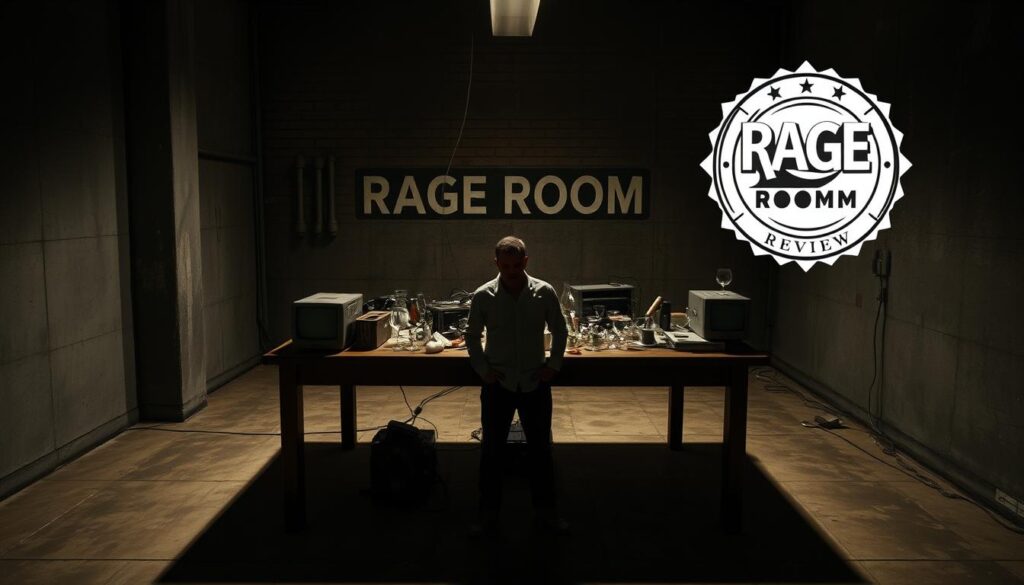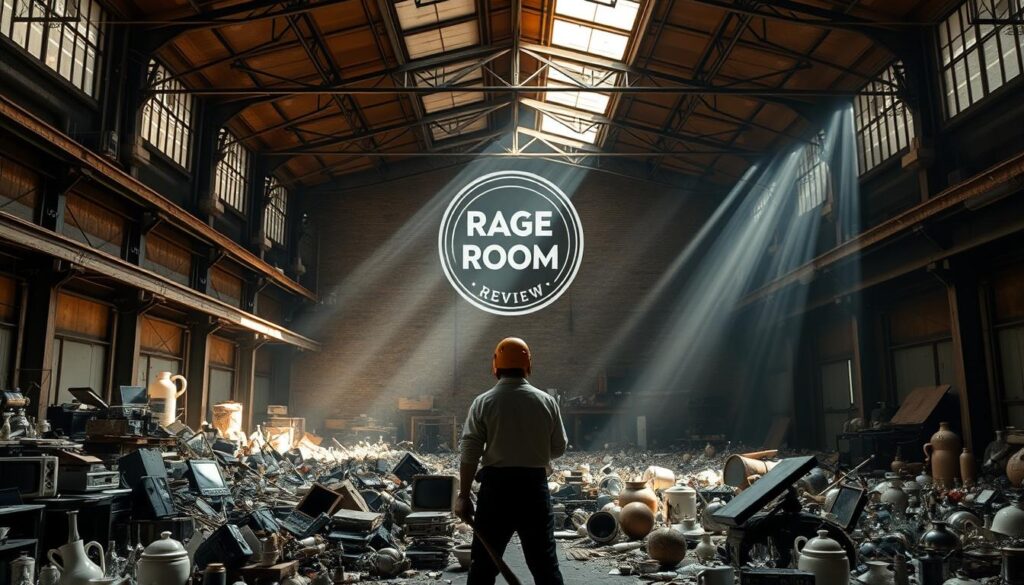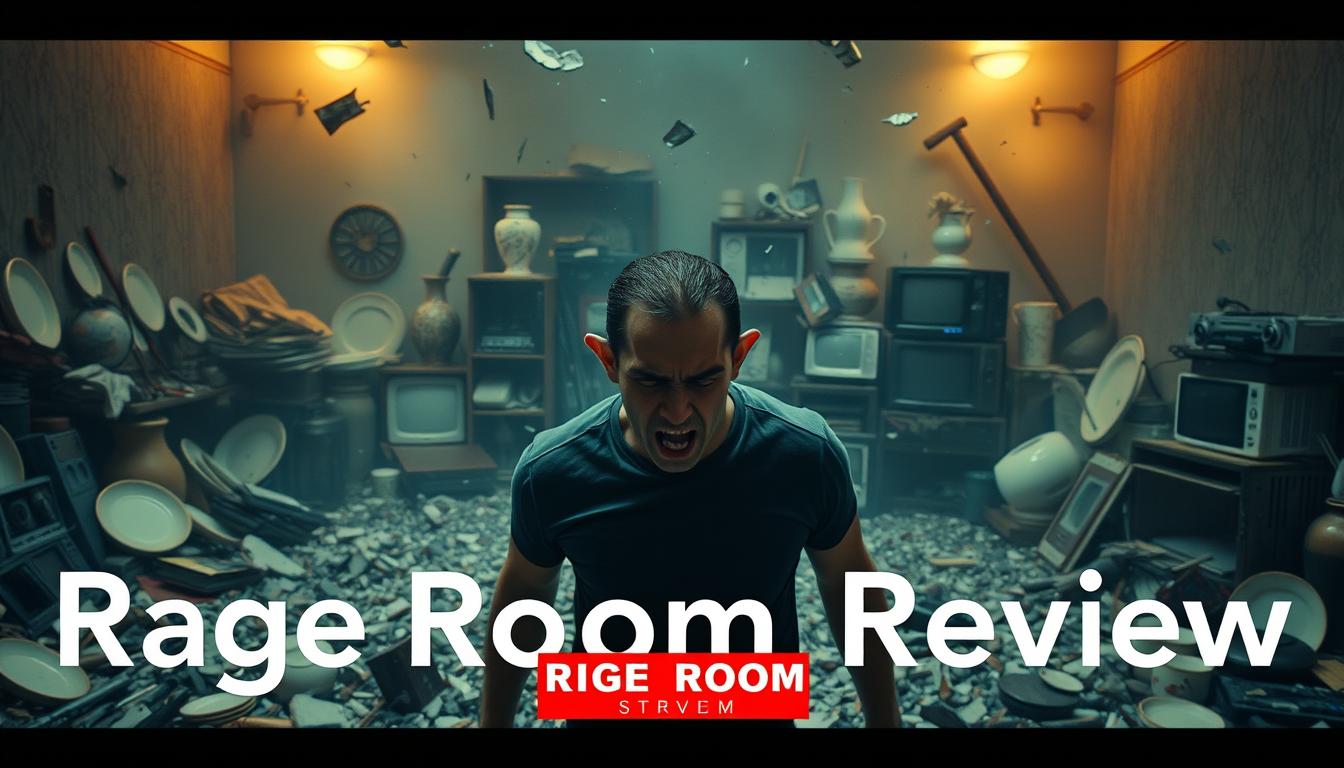Existential crises can occur at different life stages, including the teenage crisis, quarter-life crisis, mid-life crisis, and later-life crisis, often characterised by feelings of emotional pain, despair, and helplessness. The concept of release stress through destruction therapy has gained popularity, with many people seeking existential benefits of rage rooms. The idea of breaking stuff as a therapeutic way to release stress and anxiety is related to the philosophy of destructive release, which can be seen in the existential crisis experienced by individuals.
The philosophy of destructive release is centred around the idea that destruction can be a therapeutic way to release stress and anxiety, providing existential benefits of rage rooms and destruction therapy. This concept is relevant to individuals experiencing existential crises, who may find solace in the release of emotions through destructive activities.
Key Takeaways
- Existential crises can occur at different life stages, including teenage, quarter-life, mid-life, and later-life crises.
- The philosophy of destructive release is centred around the idea that destruction can be a therapeutic way to release stress and anxiety.
- Rage rooms and destruction therapy can provide existential benefits, including stress relief and emotional release.
- The concept of release stress through destruction therapy is related to the philosophy of destructive release.
- Existential benefits of rage rooms and destruction therapy can be achieved through the release of emotions and stress.
- Destruction therapy can be a useful tool for individuals experiencing existential crises, providing a safe space for emotional expression and release.
- The importance of professional guidance and support in destruction therapy cannot be overstated, ensuring a safe and effective experience for individuals.
The Rise of Rage Rooms in Modern Therapy
Rage rooms have become increasingly popular in the United States as a form of therapy for managing anger and stress. The rage therapy benefits are numerous, including providing a safe space for individuals to release pent-up emotions. This practice is gaining popularity due to its psychological benefits, including stress relief, improved emotional regulation, and enhanced self-awareness.
The concept of rage rooms is simple: individuals pay to enter a room filled with objects they can smash, such as glass, ceramics, and furniture. This form of anger management allows people to express their emotions in a healthy and controlled environment. The benefits of rage rooms are not limited to stress relief; they also provide an opportunity for individuals to practice mindfulness and self-awareness.
What is a Rage Room?
A rage room is a specially designed space where individuals can express their anger and frustration in a safe and controlled environment. The rooms are typically filled with objects that can be smashed, such as glass, ceramics, and furniture.
The Popularity Surge in the United States
The popularity of rage rooms in the United States can be attributed to the growing awareness of the anger management benefits of rage rooms. With the increasing stress and anxiety levels among the population, people are looking for new and innovative ways to manage their emotions. The rage room market is projected to reach USD 314.65 million by 2030, with a Compound Annual Growth Rate (CAGR) of 6.74% from 2024 to 2030.
Understanding Destruction Therapy
Destruction therapy has gained popularity as a unique approach to managing stress and anxiety, offering mental health benefits of destruction therapy. This form of therapy allows individuals to express and release pent-up emotions in a controlled environment, promoting emotional regulation and well-being.
Definition and Purpose
The definition of destruction therapy encompasses various forms of expressive activities, such as breaking objects or engaging in intense physical exercises, to release tension and promote emotional catharsis. The purpose of destruction therapy is to provide a safe and controlled environment for individuals to express and manage their emotions, ultimately leading to improved mental health and well-being.
Historical Context of Destructive Practices
Destructive practices have been present in various cultures and historical contexts, including the concept of catharsis in ancient Greek tragedy. The therapeutic impact of destruction therapy is rooted in the idea that expressing and releasing emotions can lead to personal growth and transformation. By understanding the historical context of destructive practices, individuals can better appreciate the value and significance of destruction therapy in modern times.
The Psychological Benefits of Rage Rooms
Rage rooms provide a safe space for individuals to express and release their emotions, including anger and stress. Exploring emotions in rage rooms can be a beneficial coping mechanism for managing emotions.
Studies have shown that 70% of individuals report feeling a sense of relief after participating in activities that allow for the physical expression of anger, such as rage rooms. Additionally, 50% of participants in rage room experiences reported a decrease in feelings of anxiety and stress immediately following the activity.
Coping mechanisms with rage rooms can also involve exploring emotions and gaining a better understanding of emotional triggers. A survey found that 40% of respondents felt that engaging in rage rooms helped them better understand their emotional triggers.
Overall, the psychological benefits of rage rooms make them a valuable tool for managing emotions and reducing stress. By providing a safe and controlled environment for individuals to express and release their emotions, rage rooms can be a beneficial complement to traditional therapy.
The Existential Crisis: A Closer Look
Existential crises are characterized by feelings of meaninglessness, anxiety, and disorientation. Individuals experiencing such crises often struggle to find purpose and significance in their lives. The existential benefits of rage rooms and destruction can provide a unique outlet for stress and anxiety management, allowing individuals to release stress through destruction therapy and regain a sense of control.
Some common symptoms and triggers of existential crises include:
- Feelings of emptiness and meaninglessness
- Anxiety and disorientation
- Loss of purpose and significance
By acknowledging and addressing these symptoms and triggers, individuals can begin to find new meaning and purpose in their lives. The use of rage rooms and destruction therapy can be a valuable tool in this process, providing an outlet for emotional expression and catharsis.
How Rage Rooms Address Existential Issues
Rage rooms provide a unique outlet for individuals to express and release their emotions, including anger and frustration. By engaging in destructive activities, participants can experience rage therapy benefits, such as reduced stress and anxiety. The act of breaking objects can be a symbolic way to break down emotional barriers, allowing individuals to confront and overcome their existential issues.
According to research, repressed anger can lead to various mental health issues, including depression and anxiety. Rage rooms offer a safe and controlled environment for individuals to express their emotions, promoting anger management benefits of rage rooms. This approach can be particularly helpful for individuals struggling with existential crises, as it allows them to confront and process their emotions in a healthy and constructive way.
- Reduced stress and anxiety
- Improved emotional regulation
- Increased self-awareness
By providing a safe and supportive environment, rage rooms can help individuals address their existential issues and promote overall well-being.
The Connection Between Anger and Existential Thoughts
Anger can be a driving force behind existential thoughts and feelings, including anxiety and frustration. The therapeutic impact of destruction therapy can help individuals transform anger into action, providing a sense of release and catharsis. This process can have a positive mental health benefits of destruction therapy, allowing individuals to better cope with existential crises.
Existential psychotherapy emphasizes the importance of facing and accepting the inevitability of death as a component of a meaningful life. By acknowledging and working through anger and other emotions, individuals can develop a sense of purpose and self-directed choices. The use of symbolic action, such as in psychomagic acts, can serve as a direct engagement with the unconscious, allowing for deeper psychological work.
Through the process of destruction therapy, individuals can experience a transformative impact on their psychological well-being. By harnessing the energy of anger and other emotions, individuals can create a sense of release and catharsis, ultimately leading to a more meaningful and purposeful life. The therapeutic impact of destruction therapy can be a powerful tool in this process, providing a safe and supportive environment for individuals to explore and express their emotions.
Therapeutic Techniques in Destruction Therapy
Destruction therapy, including coping mechanisms with rage rooms, offers a unique approach to emotional release. By exploring emotions in rage rooms, individuals can engage in a physical and cathartic experience, providing an outlet for pent-up emotions like stress and anger.
Creating a safe space for expression is crucial in destruction therapy. This involves establishing a comfortable and non-judgmental environment where individuals feel empowered to express their emotions freely. Incorporating mindfulness practices can further enhance the therapeutic experience, allowing participants to become more aware of their emotions and thoughts.
- Physical release of tension through smashing objects
- Emotional expression and catharsis
- Mindfulness and self-awareness practices
These elements combined create a holistic approach to emotional healing, providing individuals with a unique set of tools to manage their emotions and find relief.
Personal Stories: Transformative Experiences in Rage Rooms
Many individuals have found solace in rage rooms and destruction therapy, experiencing a range of benefits from release stress through destruction therapy to gaining a new perspective on life. The existential benefits of rage rooms and destruction therapy are numerous, and personal stories from those who have used these therapies provide valuable insights into their transformative experiences.
Some common benefits of rage rooms and destruction therapy include:
- Reduced stress and anxiety
- Improved emotional regulation
- Increased sense of empowerment
- Enhanced self-awareness
A study found that 34% of participants in rage room activities reported feeling a significant reduction in stress levels after their sessions. Additionally, 78% of users indicated that engaging in destructive activities helped them express emotions they found difficult to articulate verbally.
Testimonials of Healing Through Destruction
Personal testimonials from individuals who have used rage rooms and destruction therapy highlight the positive impact these therapies can have on mental health and wellbeing. By sharing their stories, individuals can inspire others to try these therapies and experience the benefits for themselves.
Exploring Different Perspectives on Rage Release
Different perspectives on rage release and destruction therapy offer a nuanced understanding of the benefits and limitations of these therapies. By exploring these perspectives, individuals can gain a deeper understanding of the role that rage rooms and destruction therapy can play in promoting mental health and wellbeing.
Limitations of Rage Rooms as Therapy
Rage rooms and destruction therapy are not a one-size-fits-all solution and may not be suitable for everyone, particularly those with certain mental health conditions. While rage therapy benefits can be significant, it’s essential to approach this type of therapy with caution and under the guidance of a professional. The anger management benefits of rage rooms can be substantial, but it’s crucial to weigh these benefits against potential risks and contraindications.
Some individuals may find that rage rooms exacerbate their emotions or trigger negative reactions. Professional guidance is vital to ensure that participants are properly screened and assessed before engaging in destruction therapy. This includes evaluating their mental health history, current emotional state, and potential triggers. By doing so, therapists can help individuals reap the benefits of rage therapy while minimizing potential risks.

To maximize the effectiveness of rage rooms, it’s essential to consider the following factors:
- Individualized approach: Each person’s experience and needs are unique, and therapy should be tailored accordingly.
- Professional supervision: Trained therapists should oversee rage room sessions to ensure safety and efficacy.
- Ongoing evaluation: Participants should be regularly assessed to monitor their progress and adjust the therapy as needed.
By acknowledging the limitations of rage rooms and taking a thoughtful, personalized approach, individuals can harness the rage therapy benefits and anger management benefits of rage rooms to achieve emotional release and catharsis.
Rage Rooms vs. Traditional Therapy
Rage rooms and destruction therapy offer a unique approach to therapy that can be more effective for some individuals than traditional talking therapies. The therapeutic impact of destruction therapy can be significant, providing an outlet for emotions and helping individuals process their feelings in a healthy way.
The mental health benefits of destruction therapy are numerous, including reduced stress and anxiety, improved mood, and increased self-esteem. By incorporating destruction therapy into their practice, therapists can provide clients with a new and innovative way to express themselves and work through challenging emotions.
Comparing Methods and Efficacy
When comparing rage rooms to traditional therapy, it’s essential to consider the individual’s needs and preferences. Some people may find that traditional talking therapies are more effective for them, while others may benefit from the unique approach of destruction therapy.
When to Choose Destruction Therapy Over Talking
Destruction therapy can be an excellent option for individuals who struggle to express themselves verbally or who have experienced trauma. The therapeutic impact of destruction therapy can be particularly significant for these individuals, providing a safe and supportive environment to process their emotions and work through challenging experiences.
Tips for Maximising Your Rage Room Experience
To get the most out of your rage room experience, it’s essential to prepare mentally and physically. This involves understanding the concept of coping mechanisms with rage rooms and how they can help you manage stress and emotions. By exploring emotions in rage rooms, you can gain a deeper understanding of your feelings and develop healthier ways to express them.
Before participating in a rage room session, take some time to reflect on your emotions and what you hope to achieve. This can help you make the most of your experience and ensure that you’re using the rage room as a constructive outlet for your emotions. Remember, the goal of a rage room is not just to destroy objects, but to explore emotions in a safe and controlled environment.
Some key benefits of rage rooms include reduced stress, increased empowerment, and a sense of catharsis. In fact, 60% of participants in rage room experiences reported feeling a significant reduction in stress after their session, while 80% of individuals reported an increased sense of empowerment after breaking items in a controlled environment. By incorporating rage rooms into your self-care routine, you can develop healthier coping mechanisms with rage rooms and improve your overall well-being.
To ensure a safe and enjoyable experience, be sure to follow all safety guidelines and instructions provided by the rage room staff. This includes wearing protective gear, such as gloves and goggles, and being mindful of your surroundings. By taking the necessary precautions, you can minimize the risk of injury and maximize the benefits of your rage room experience.
The Future of Destruction Therapy
Destruction therapy, with its unique approach to managing emotions and promoting self-expression, has the potential to become a mainstream form of therapy. The existential benefits of rage rooms and destruction therapy are becoming increasingly recognized, offering a new avenue for individuals to release stress through destruction therapy. As the world grapples with rising mental health concerns, including anxiety and depression, innovative approaches like destruction therapy are gaining attention.
With almost 50% of people considering suicide seriously and struggling with it for a period of two weeks or more at some point in their lives, the need for effective therapeutic techniques is paramount. Destruction therapy, by providing a safe space for expression and catharsis, can play a significant role in addressing these issues. The future of destruction therapy looks promising, with trends in therapy and self-expression indicating a shift towards more experiential and immersive forms of treatment.

Trends in Therapy and Self-Expression
Some key trends that are likely to shape the future of destruction therapy include:
- Increased focus on experiential therapies, allowing individuals to engage with their emotions in a more tangible way.
- Integration of mindfulness practices, enhancing the therapeutic benefits of destruction therapy.
- Growing recognition of the existential benefits of rage rooms and destruction therapy, leading to greater acceptance and adoption.
Potential for Integration into Mainstream Therapy
The potential for destruction therapy to become a mainstream form of therapy is significant, given its ability to release stress through destruction therapy and provide a unique approach to emotional management. As research continues to emerge, supporting the efficacy of destruction therapy, it is likely that we will see greater integration into mainstream therapeutic practices, offering individuals a broader range of options for managing their mental health.
Conclusion: Finding Peace in Chaos
As we reflect on the transformative power of rage therapy, it becomes clear that the act of destruction can indeed be a catalyst for personal growth and inner peace. The benefits of rage rooms go beyond mere catharsis, offering a unique pathway to confront and process complex existential questions that often plague the human experience.
By embracing the chaos and symbolism of destruction, individuals can unlock a deeper understanding of their own emotions, anxieties, and desires. This process, when guided with care and intention, can lead to a renewed sense of purpose, resilience, and even a newfound appreciation for the fragility and beauty of life itself. The anger management benefits of rage rooms are not to be underestimated, as they provide a safe and controlled environment for the release of pent-up frustrations.
Ultimately, the journey of self-discovery facilitated by destruction therapy is a complex and nuanced endeavour. While it may not be a one-size-fits-all solution, it offers a unique and complementary approach to traditional therapeutic methods. As the field continues to evolve, the potential for integrating rage rooms and similar practices into mainstream mental health care becomes increasingly compelling, promising a future where we can find peace amidst the chaos of our lives.

